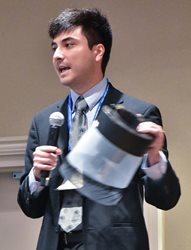
Whatever happened to VectorWEB, winner of the inaugural Innovations Pitch Competition at the 2018 Annual Meeting in New Orleans? Did they use the feedback from the pitch competition’s coaches and judges to advance their innovative solution to mitigate outbreak-prone disease?
Represented at #TropMed18 by team members Tristan Ford and Margaret Glancey, VectorWEB was developed at the Johns Hopkins University Center for Bio-engineering, Innovation, and Design in Baltimore. This low-cost network of cloud- connected ovitraps provides a technological solution to generate higher-quality data for more effective control against vectors of mosquito-borne diseases. By remotely and automatically identifying field-collected mosquito specimens, VectorWEB provides real-time mosquito population data. The system’s automated mosquito traps and software (a smart-imaging attachment for commercial mosquito traps) allows public health systems to collect surveillance data faster through the company’s image classification algorithms. Fueled by a large, proprietary database, VectorWEB enables strategic planning for mosquito abatement districts, targets control strategies that reduce mosquito populations and prevents disease transmission.

Over the past year, VectorWEB has continued to expand their unpublished image database of thousands of images of mosquitos, labelled by species based on molecular ID. Using this data in conjunction with novel techniques in image processing and computer vision, VectorWEB has been able to achieve over 90% classification accuracy based on images of mosquitoes. These algorithms are being integrated with hardware-automated trap prototypes capable of achieving the required image resolution and durability in the field. Field studies in the Northeastern U.S. are demonstrating the potential for remote species classification to transform vector surveillance. Their prototypes have been optimized to last up to four weeks in the field before requiring a battery change and maintenance.
VectorWEB continues to use the validation, feedback and connections from winning the Innovations Pitch Competition, a grant a U.S. Agency for International Development “Combating Zika and Future Threats Grand Challenge” grant, and other honors and awards to expand their core technology to malaria entomological surveillance. They continue to develop their commercialization plan and aim to offer an initial product in 2020.
Tristan will serve as one of the five judges for this year’s Innovations Pitch Competition. A project engineer and commercialization lead for VectorWeb, Tristan has contributed to two patents, earned awards at various pitch competitions, and received a Boren Fellowship for research in Brazil. He earned his undergraduate degree in biomedical engineering from the University of Rochester and a Master’s degree in bioengineering innovation from Johns Hopkins University.
The Innovations Pitch Competition was developed by longtime ASTMH member May Chu, a former CDC official who has participated in multiple outbreak responses, field work and has led the building of sustainable laboratory systems in the aftermath of the 2001 U.S. anthrax attack, SARS in China, Lassa fever, Ebola and Marburg virus outbreaks in Africa and pandemic influenza response. Seconded to the White House Office of Science and Technology Policy in 2014 and 2015, she worked with the US Agency for International Development on Fighting Ebola: A Grand Challenge for Development to develop a better protective suit and other medical aids to mitigate the Ebola epidemic. At #TropMed17, a symposium on those innovations were presented as way to share ideas and continue the discussion. The symposium idea was well received and a number of ASTMH leadership thought that a similar pitch session at the Annual Meeting would provide a new, time-relevant and lively session that brings great ideas out of labs and helps make them sustainable.
The 2nd annual Innovations Pitch Competition will feature innovative ideas for mitigating outbreak-prone disease risk through novel uses of social communication, improved predictive capabilities or development of better tools to detect disease, control disease, and disseminate information on disease spread. A wide range of ideas, from early-stage concepts to field-tested prototypes, will be presented. This year, the pitch competition places greater emphasis on how these innovative ideas will improve outbreak-prone disease response in low-resource settings. Five innovator/innovation team finalists have been chosen from a global team of reviewers and are being coached on how to pitch their innovative ideas by a team of experts.
At this year’s Innovations Pitch Competition session, the five finalists will give a rapid-fire pitch (10 minutes) in front of a live audience and a judging panel composed of global health innovations experts. Questions from the audience and real-time voting will be conducted. The winner of the session will be determined using a weighted score that factors in the judges’ scores and the audience votes. The winner will receive a monetary award ($10,000 USD), marketing advice and an introduction to potential investors. Runners-up will receive cash prizes as well.
For more information, visit VectorWEB at
https://www.vectech.io/.